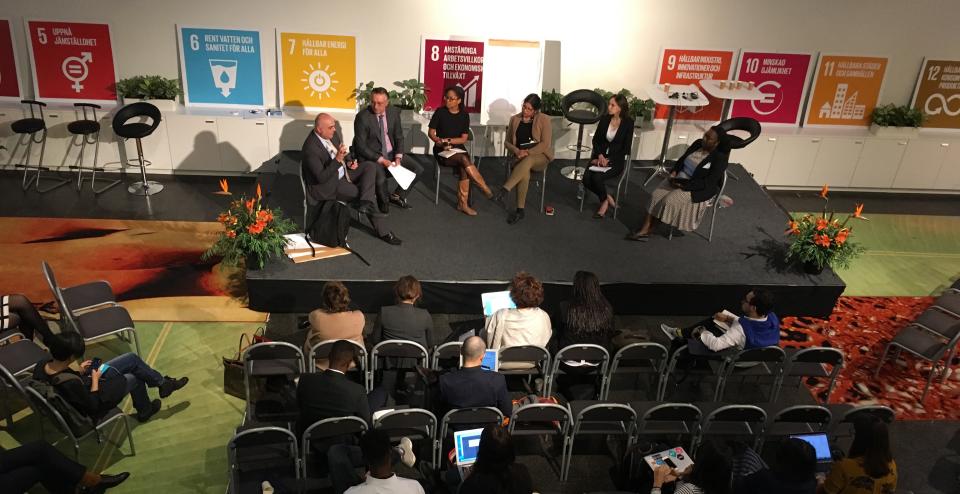
Photo taken by author at SIF 2017
Hundreds of activists, advocates, journalists, researchers, donors, and just about everyone else converged into the second-largest archipelago in the Baltic Sea – the city of Stockholm – to discuss powe“r and access online. 10PM sun aside, this year’s Stockholm Internet Forum (#SIF17) for easy tracking of the event on Twitter) was stronger than ever before and saw its participants and panelists talk about some real hard and somewhat depressing questions.
After all, the Arab Spring is long gone and the initial feel-good effects of the Internet have also worn out. Add in the recent political changes that have been shaping the world (or rather tearing it apart), the failure to deal with online harassment and trolls despite years of push on social media networks and we kind of expected a somber event. While there may have been less fun and fewer jokes, it also ensured that we stayed on the difficult topics and tried to get some new solutions to old problems, looking at them somewhat differently thanks to a varied participant list that became part of the SIF community.
Access
The focus on this year’s SIF was around the critical issues of access and power. When talking about access and power, the discussion naturally comes to why there aren’t as many women in online spaces even after years of civil society’s hard work. Are we ignoring something crucial when trying to talk about access? Do we need to focus more on power and how to empower women before they could have access to the Internet?
Are we ignoring something crucial when trying to talk about access? Do we need to focus more on power and how to empower women before they could have access to the Internet?
During the opening session of Framing Access and Power at Stockholm Internet Forum 2017, one participant referring to the history of struggles of access and power during print media commented – perhaps it’s not about the online media (or any other form of media) but the ‘human nature’. He suggested that we should go one layer deeper and look at the psychological reasons before focusing on the Internet itself when dealing with issues like fake news or harassment.
While this comment was made in terms of hate speech, unsafe spaces, and government’s overbearing control connecting it to how governments also used to control print media, it could very well be taken in the context of lack of women internet users – reasons behind fewer women in real life public spaces transitioning into the online spaces.
This thought from the opening session on focusing on cultural deterrents – if we may call them so – could very well be applied to a parallel pre-SIF session on “Online threats: Operational response and kick-ass solutions” that focused on how to deal with online threats where a strong panel offered solutions based on their own local success stories.

Photo taken by author at SIF 2017
Going back to access and looking from the Pakistani perspective, I think the majority of women aren’t online yet because they don’t have the means. The lack of women online has nothing to do with any new reasons that may have come after the ‘invention’ of the Internet. It all goes back to how things used to be before the internet.
- Who has the decision power? men are the head of the house
- Who has the economic power? fewer women have jobs or own businesses; those who do earn less than men
- Who has the cultural power? women aren’t allowed in public spaces so shouldn’t be ‘allowed’ online spaces too
All of the above has remained true for what seems like a forever. But most of this boils down to the lack of women participation in the country’s economic development.
Men earn, which means they have the power to make decisions, allocate funds, and that also means that they first focus on their own communication and entertainment before funding their wives’, sisters’ or mothers’ who may very likely be depending on them for finances. Even in the younger generation, boys get smartphones before their (even elder) sisters because, well – ‘they go out of the house more’.
This unfortunately possibly means that no advocacy or digital rights group has the power to bring more women online specifically in countries where women aren’t economically involved. Until they do so, until there’s a cultural shift that helps more women make their own money, until there’s a shift from a patriarchal to an equal society, can we really expect a small civil society group will be able to offer internet access to more women? Even if there are collaborations and more donors are involved, would these organizations be funding women’s monthly internet bills — no matter how small? Can even the governments of developing countries help more women get access to the internet when they have been unable to bring them in the workforce?
Until there’s a cultural shift that helps more women make their own money, until there’s a shift from a patriarchal to an equal society, can we really expect a small civil society group will be able to offer internet access to more women?
But then is it pragmatic that we focus so much on access alone and not on the power dynamics of any local region that we are trying to focus on?
Power
Another Pre-SIF Parallel Session titled “Financial services in a digital era: Development, livelihoods and privacy” (sort of) answered this nagging question in my mind. While a lot has been said on the drawbacks of mobile money schemes or microfinance projects designed exclusively for women, they do bring some sort of relief from cultural barriers that many women in the developing or religiously conservative countries are stuck in.
Talking to Fahmida, a home-based artist in rural Sindh who offers traditional embroidery work to her clients, it was evident how Easypaisa [1] – a digital financial service – has helped her get more clients that aren’t just in her neighborhood. Fahmida has transformed her neighborhood clientele to a national level where she advertises her work through Facebook and gets paid through Easypaisa – all without stepping out of her home.
Fahmida has transformed her neighborhood clientele to a national level where she advertises her work through Facebook and gets paid through Easypaisa – all without stepping out of her home.
Easypaisa was launched in Pakistan to tap the “unbanked population” of the country, aimed largely at men who work in big cities to help them send money to their families in rural regions. However, it has increasingly become a tool for women who aren’t allowed to go to banks for opening their accounts to be a part of the economy and become financially independent.
I get money from a shop I buy clothe from in the bazar. I don’t have to make any separate trips for the payments and more importantly I don’t have to go to the banks or get my national identity card made without which they won’t open my account – Fahmida.
There are also many others, from home-based bakers to tailors to artists and makeup vendors, who weren’t doing any business before and started after it was possible for them to get paid this conveniently through digital financial services.
But, a fellow SIF participant during the session of Digital Financial Services commented how she was annoyed of hearing so much about digital services. “Why are we focusing so much on mobile money when we should first be focusing on access?”
A valid comment, but a linear approach may not always be a utilitarian choice. For example, Fahmida had barely any access to the internet since she was dependent on her father’s phone. She used the smartphone mainly to send text messages to her friends or talk to her clients. But after Easypaisa enabled her to expand her business, get more clients, and thus make more money, she now has her own smartphone ensuring 24/7 access to the internet.
Fahmida used the smartphone mainly to send text messages to her friends or talk to her clients. But after Easypaisa enabled her to expand her business, get more clients, and thus make more money, she now has her own smartphone ensuring 24/7 access to the internet.
Yes, access is critically important and should be a focus to bring more women online. But, taking the first comment from the opening session of SIF17 about going a level deeper and looking at human nature – or, to put it in other words, cultural barriers – we can probably achieve faster and better results by several other routes, as well. In the Pakistani context, more women will be online once they aren’t financially dependent on their husbands, fathers, or brothers to support their bills. With mobile financial services, if this segment can be pushed to work and earn money of their own, we may very well see quicker hikes in the graph of women internet users.

Photo taken by author at SIF 2017
In a tangential discussion in a small group, another aspect of power was discussed – governmental power that is repressive. Stella Nyanzi was arrested for being critical of the government and engaged in civil disobedience by talking about social issues in overtly sexual ways. The question then raised was whether we need to move beyond access and look at how we deal with governmental power, regional customs and ethical issues surrounding self expression, sexuality and other issues.
But, can we really move beyond access and focus entirely on power? At least in the local context of Pakistan, if digital rights organizations will start talking about sexuality or start questioning cultural norms around how women dress, walk or talk, they’d be further isolated by their communities who will take it as a war against their culture or religion.
By keeping the discussion strictly on access and women’s inclusion in economy and then going forward using the sheer force of economically-abled and socially connected women, the online spaces can be used to start discussing other social and cultural issues.
In the end …
What remains is the question whether it is possible to focus on both the power and access together or if we need to wait until there are more women online to start discussing how to deal with post-access power issues that were discussed at SIF, including net neutrality, censorship, sexuality online, local customs transcending into the realm of online spaces, and laws that help persecute online dissidents.
At the end of SIF and after not only following several panel talks but listening to different voices from all over the world, including Sweden – I realise that this is probably the perfect time for regions that aren’t facing such a stark discrimination in the number of women internet users to discuss the shape of the internet today. How government or private companies’ are increasing power over the internet and how we need to do further research on social and cultural norms are affecting online discourse.
However, for countries like Pakistan, the focus has to remain on access and socioeconomic development of women to help them get connected and perhaps find economic opportunities online before venturing into discussions on local customs, and risk losing them entirely to the power the men in their houses already have.
Footnotes
1. Easypaisa is offered by local shops of all kinds – merchants, cafes, tobacco shops – where anyone can go, show the confirmation text message and get the money. The service is offered both as over-the-counter transactions through Easypaisa outlets or through mobile phones using mobile accounts. More can be found here: https://www.easypaisa.com.pk/about-easypaisa-1
- 6566 views






Add new comment